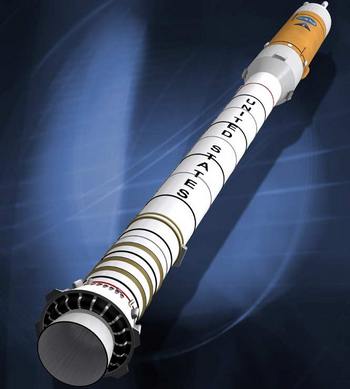NASA has identified possible solutions to a potential vibration risk to the crew on the Ares I launch vehicle. But the US space agency does not believe the problem is as serious as it first thought.
The issue is a potential coupling between thrust oscillations in the solid rocket motor (SRM) first stage and vibration modes in the launch vehicle. Identified in October 2007, the problem is the top risk in the Ares I programme, says Rick Gilbrech, associate administrator, exploration systems.
The frequency of pressure pulses in the five-segment SRM is close to the natural frequency of the second longitudinal vibration mode of the complete launch vehicle. This creates the risk of a "pogo stick" resonant vibration, says Garry Lyles, associate director for technical management, Marshall Space Flight Center.

© NASA
After further analysis, Lyles says, NASA believes there is little or no risk to the structure and systems of the launch vehicle, but there is still concern the vibration could make it difficult for the Ares I crew to perform their tasks, including reading their flight displays.
Two mitigation options will be pursued in parallel with development of the crew launch vehicle leading up to the preliminary design review in September. The primary option is to install tuned mass dampers inside the vehicle. "These vibrate at a frequency counter to the natural frequency of the vehicle and cancel the vibration," Lyles says.
The second option is to "detune" the vehicle by lowering its natural frequency to move it away from the frequency of thrust oscillations in the SRM. A third option would be to modify the internal flow in the rocket motor to change the frequency of its pressure pulses. "We could do that in the future, but not early in the programme," he says.
Much of the work since October has been to look closely at the Ares I to remove any "overconservatism" in the design. As a result, NASA now believes the problem is restricted to a "very narrow band" where the the second vibration mode natural frequency of 11.7Hz is close to the thrust oscillation frequency of 12Hz.
Lyles says thrust oscillation is a characteristic of all SRMs and is caused by "organ pipe" acoustic resonance as a pressure wave travels up and down the length of the motor. The four-segment Space Shuttle solid rocket booster produces pressure pulses at 15Hz, which reduces to 12Hz in the longer five-segement Ares I first stage.
The pressure pulses are small - 0.5-1.5% of the maximum static pressure inside the motor, which peaks at just below 1,000lb/in², says Lyles. But the vehicle is sensitive to even small pulses when they are close to the natural frequency of its second longitudinal vibration mode, he adds.
To further remove conservatism and reduce risk, Lyles says NASA plans to obtain additional data on the coupling of the SRM's structural response to thrust oscillations on future Shuttle flights, beginning in August, and on the first two Ares I unmanned test flights, Ares I-X and Ares I-Y.
The tuned mass dampers are likely to be installed at the top of the vehicle, in the parachute compartment, and the bottom, in the SRM aft skirt. There are other places in the vehicle where they can be located, Lyles says. The idea is to spring-mount existing mass so as not to add weight to the vehicle.
"The real impact we are seeing is on the Orion spacecraft and its crew," says Lyles. NASA will also look at installing shock absorbers under the crew seats to reduce vibration. "It's hard to read the consoles if vibration gets beyond 0.25-0.3g," he says.
Source: FlightGlobal.com
















